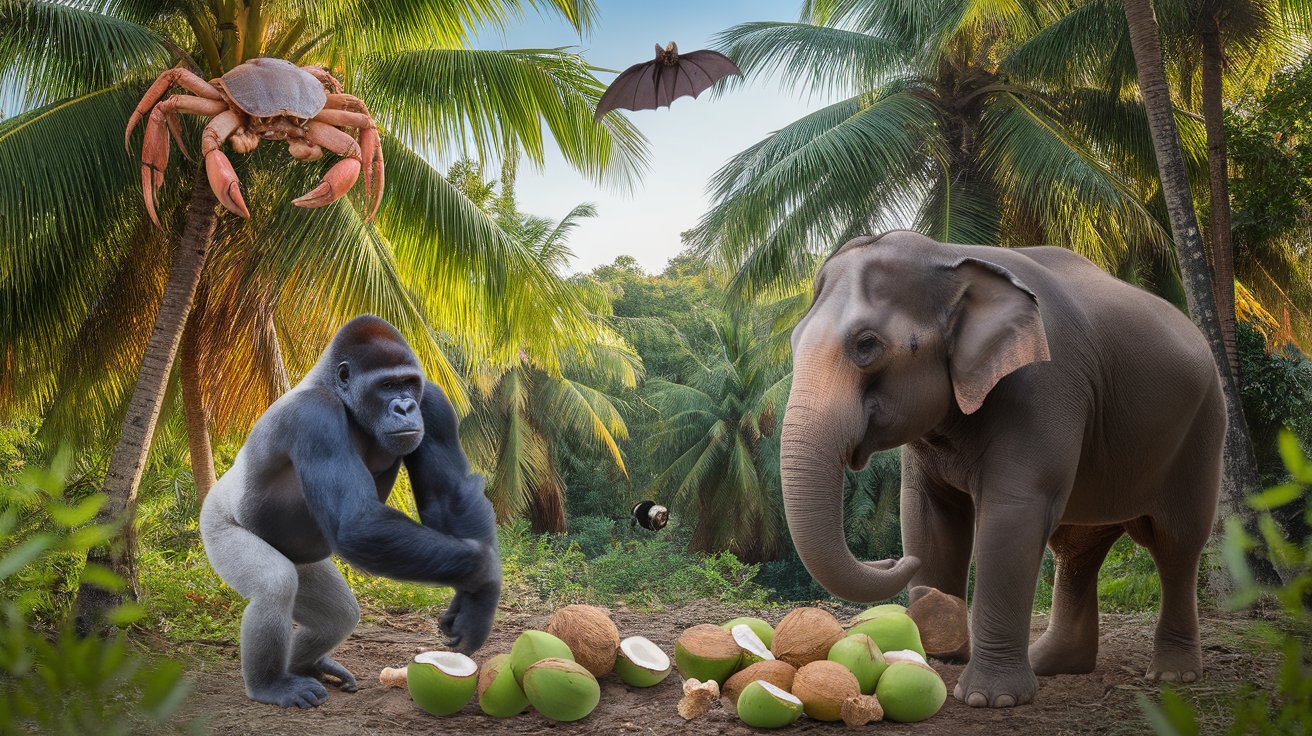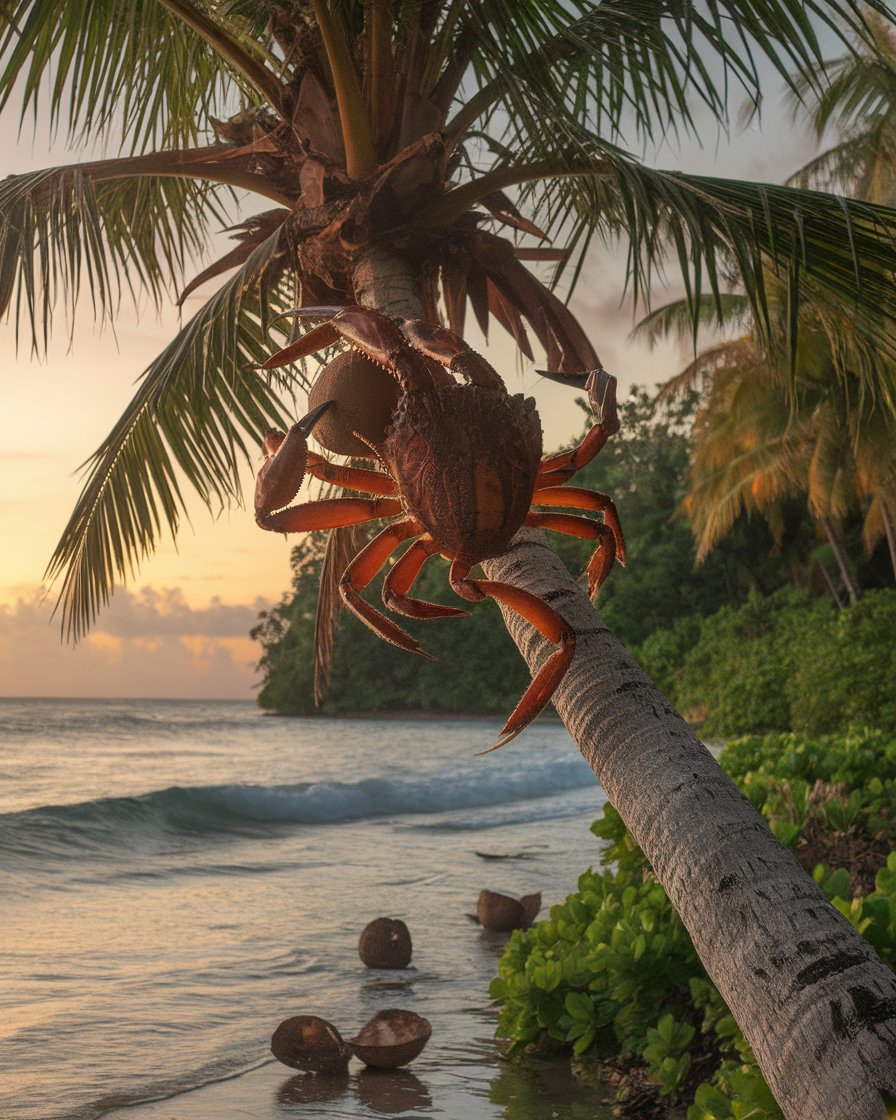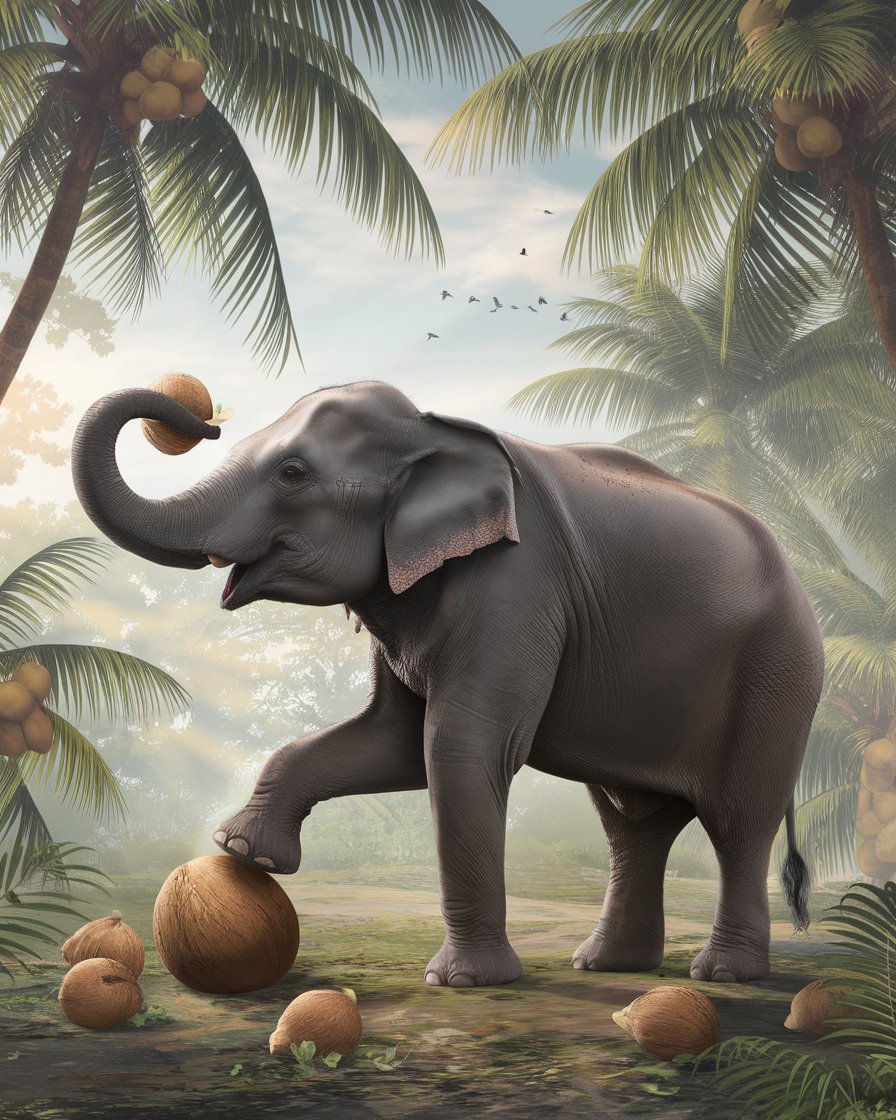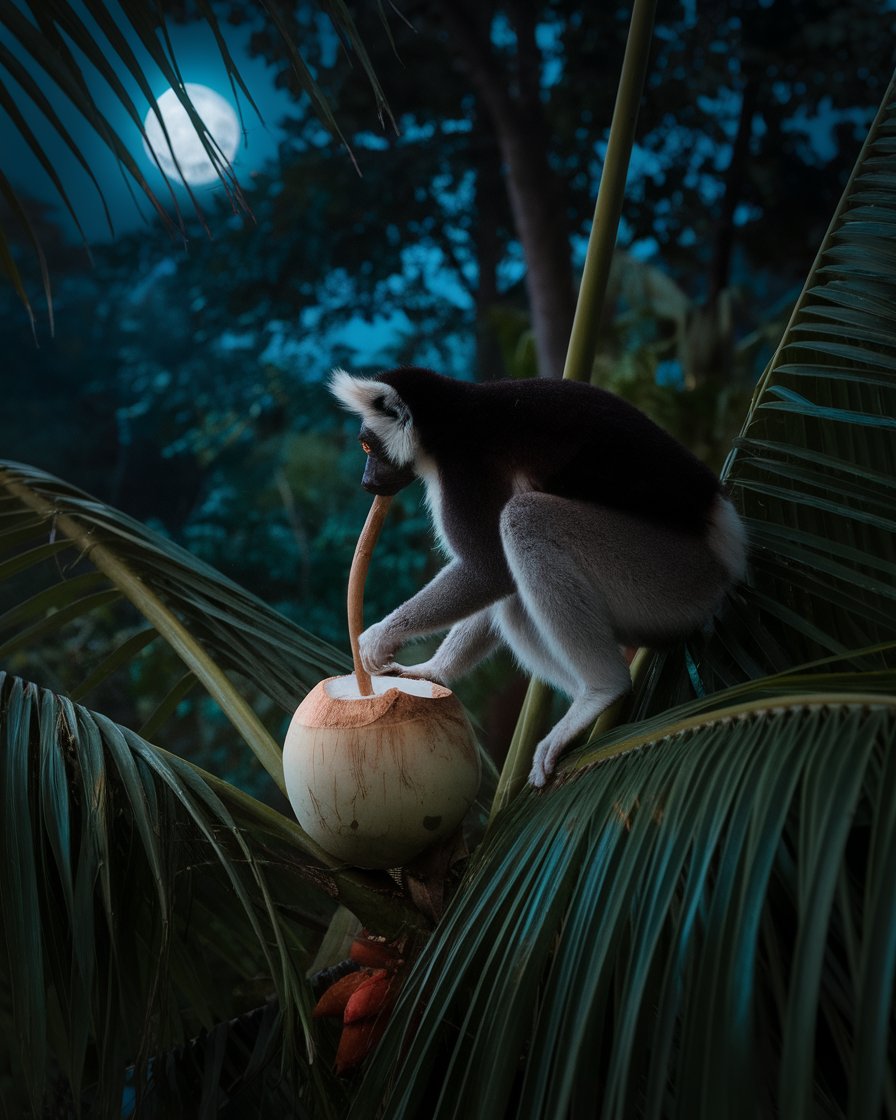Introduction
Coconuts are a crucial part of the diet for many animals found in tropical regions. From the mighty coconut crab, the largest terrestrial crab known for its ability to crack open coconuts with its powerful claws, to fruit bats and rhinoceros beetles, various animals consume coconuts as part of their diet. These creatures have adapted unique ways to access the nutrient-rich coconut meat and water inside. Animals like monkeys, sun bears, and even gorillas have shown interest in coconuts, using their strength and skills to enjoy this tropical fruit when found in the wild.
The process of cracking open a coconut isn’t easy, but many animals have developed techniques to rip open the tough shell. Some animals, like coconut crabs and aye-ayes, use their natural tools—claws and teeth—to gain access to the coconut flesh. Whether it’s for sustenance, hydration, or simply enjoying the sweet coconut water, these animals have proven their resourcefulness when coconuts are available in their habitats.
Key Takeaways
- Coconut crabs use their powerful claws to crack open coconuts, making them the largest terrestrial crabs in tropical regions.
- Elephants use their size and strength to crush coconuts, consuming the meat and water to maintain hydration and nutrition.
- Gorillas, though primarily herbivores, occasionally consume coconuts by breaking open the hard shell with their powerful jaws.
- Aye-ayes use their sharp teeth and specialized middle finger to access coconut flesh, showcasing their unique foraging abilities.
- Coconuts provide a vital source of nutrients, hydration, and energy for various animals found in tropical regions.
- Many animals, including monkeys and sun bears, have developed different techniques to crack open coconuts, highlighting their resourcefulness in the wild.
Coconut Crabs
Coconut crabs are remarkable creatures, known for their enormous size and impressive strength. These terrestrial crabs are the largest of their kind and primarily reside in tropical and subtropical regions. Famous for their ability to open the coconut, they use their powerful claws to break through the tough shells. Coconut crabs are not only fascinating for their size but also for their unique behavior and diet, which heavily features coconuts to access. Found in coastal forests, particularly in Southeast Asia, these crabs are crucial members of their ecosystem, showing a distinct interest in coconut flowers for both sustenance and shelter. These animals use their strength to crack the shells and access the flesh, making them one of the key animals that eat coconuts. They thrive alongside other species, like monkeys are known to enjoy coconuts and forage for wild dates.
10 Animals That Eat Coconuts in Tropical Regions
Coconuts are a vital food source for many animals living in tropical regions. While some animals use their strength to crack open these tough fruits, others use their dexterity or specialized tools. Here are 10 animals that eat coconuts and their unique methods of accessing the nutritious meat and water inside.
1. Coconut Crabs
Coconut crabs, the largest terrestrial crab, are known for their strength and ability to climb trees. They use their powerful claws to crack open the tough coconut shells and access the rich meat inside.
2. Monkeys
Monkeys are well-known for their intelligence and dexterity. In tropical regions, they often forage for coconuts, using rocks or sharp objects to crack them open.
3. Aye-Ayes
These nocturnal lemurs found in Madagascar use their long, thin middle finger to tap on coconuts, locate hollow spots, and break open the shell to reach the meat.
4. Fruit Bats
Fruit bats, particularly in Southeast Asia, consume the soft flesh of young coconuts. They can’t crack open hard shells, but they feast on coconuts that have been naturally split or broken.
5. Sun Bears
Sun bears, native to tropical forests in Southeast Asia, have a strong appetite for coconuts. They use their sharp claws and powerful jaws to break open the coconut shell and access the flesh.
6. Gorillas
While coconuts are not a regular part of their diet, gorillas have been observed consuming them when available. They use their strength to crack open the tough shells and enjoy the hydrating coconut water and meat.
7. Elephants
Elephants consume coconuts as part of their diet in regions where they are abundant. Although they cannot crack the coconut open with their trunk, they use their feet to crush it and then consume the meat and water.
8. Rhinoceros Beetles
The rhinoceros beetle, particularly the coconut rhinoceros beetle, is notorious for damaging coconut trees by feeding on coconut flowers and young fruits. These beetles play a significant role in the ecosystem, though often destructive.
9. Macaws
These large, colorful parrots are strong enough to crack open coconuts using their powerful beaks. Macaws enjoy both the meat and water inside the coconut.
10. Wild Pigs
In some tropical regions, wild pigs feed on coconuts. They use their strong teeth and snouts to break open the husk and access the flesh inside, often feeding on fallen coconuts.
Behavior and Habitat
Coconut crabs prefer tropical forests and coastal regions, where coconuts are abundant. These crabs, unlike most of their aquatic relatives, are land dwellers, spending much of their lives away from water. They are excellent climbers, often ascending tall coconut trees to tap the coconut to create a path to the nutritious inside. The combination of their strength and climbing ability helps them navigate their environment with ease. The tropical forests of Southeast Asia, including regions like Malaysia and Thailand, are prime locations for these crabs to thrive, offering plenty of nectar-rich coconut flowers and other food sources. With their remarkable size, the coconut crab is the largest terrestrial species of its kind, relying on ways to consume coconuts and survive in these habitats.
Feeding Habits
When it comes to feeding, coconut crabs are true omnivores. Their diet consists mainly of coconuts, but they also consume fruits, nuts, and other organic matter they find on land. They possess powerful pincers that allow them to break open the tough outer husk of coconuts and access the nutritious meat and water inside. This unique ability to crack open coconuts makes them one of the few animals capable of such a task. Additionally, coconut crabs show a strong appetite for coconuts, which serve as a primary food source, but they’ll eat other fruits when coconuts are scarce.
Elephants
Elephants are among the most majestic creatures found in tropical and subtropical regions. Known for their intelligence and social nature, they also have a varied diet that includes fruits like coconuts. Although they aren’t equipped to open the fruit or create a hole in the coconut like some other animals, elephants rely on their size and strength to crush and consume these tropical fruits. Found mostly in regions where coconuts and the coconut palm rhinoceros beetle thrive, elephants feed on the coconuts when available, whether in the wild or as part of their diet in domesticated settings. The meat of coconuts and the hydration from coconut water contribute to the overall health and well-being of these creatures, providing essential nutrients.
Case Study: Elephants and the Role of Coconuts in Their Diet
In a case study conducted at an elephant sanctuary in Thailand, researchers observed the nutritional impact of coconuts on domesticated elephants. The study focused on elephants in tropical regions where coconuts are naturally abundant, examining how these fruits contribute to the animals’ overall health. Elephants were regularly offered coconuts as part of their diet, with the research team noting how they used their feet to crush the tough shells.
The results indicated that elephants benefited significantly from both the coconut water and meat. The hydration provided by the coconut water was particularly valuable during hot seasons, while the coconut meat added essential calories and fiber to their diet. The study also found that the elephants showed a preference for fallen coconuts in their natural environment. This case illustrates the importance of coconuts in maintaining the elephants’ nutrition and overall well-being, especially in regions where other food sources might be scarce.
Elephant’s Diet Preferences
Elephants are herbivores with a love for various types of vegetation, including coconuts. In tropical regions, these animals consume different fruits that have fallen to the ground, coconuts being one of their favorites. Due to the round shape and hard shell of the coconut, elephants usually don’t crack them open like monkeys or coconut crabs. Instead, they use their powerful feet to crush the fruit, making it easier to eat. Elephants, however, do enjoy the refreshing coconut water and meat inside, which provides much-needed hydration and nutrition in their diet.
Impact of Coconuts on Elephant’s Nutrition
Coconuts are an important part of an elephant’s diet, especially in tropical and subtropical areas. While elephants may not always have access to fresh coconuts, those found in the wild often eat coconuts that have fallen from trees. These fruits offer a good source of calories and essential fibers that help with digestion. The water inside coconuts is hydrating, while the meat provides vital nutrients. Domesticated elephants, especially those in care or rehabilitation centers, are sometimes offered coconuts as a treat. The consumption of coconuts plays a key role in maintaining their energy levels and overall health.
Gorillas
Gorillas, the largest of the primates, are primarily herbivorous, relying on a diverse range of fruits, plants, and vegetation to sustain their massive bodies. While coconuts are not a common part of their diet, animals that consume coconuts like gorillas have been known to indulge when the opportunity arises. These intelligent animals often use their strength and sharp teeth to crack open coconuts using sheer force, enjoying the rich, nutritious flesh inside. Coconuts provide gorillas with essential calories and hydration, helping them maintain energy levels, especially when food is scarce. In the wild, coconuts in the wild are an opportunistic treat that adds variety to their regular fruit intake, alongside other options like coconuts as well as other fruits.
Gorillas as Coconut Consumers
Gorillas, though primarily herbivores, occasionally consume coconuts when they come across them in tropical regions. Known for their impressive strength, they can break open coconuts using their powerful jaws, making them one of the animals capable of accessing the nutritious flesh inside. Although gorillas do not rely heavily on coconuts as a food source, they have shown an interest in consuming them, especially when other fruits are less available. Coconuts, with their high-caloric content and hydrating water, are a valuable treat in the wild, contributing to their dietary diversity and overall well-being.
Coconut Consumption in Gorilla Diets
In the wild, gorillas do not have frequent access to coconuts, as these fruits are often found in regions where gorillas are not common. However, when gorillas do encounter coconuts, they seize the opportunity to enjoy this tropical fruit. The meat of the coconut provides valuable nutrients and hydration that support the gorillas’ energy needs. While coconuts do not play a significant role in the daily diets of gorillas, their consumption highlights the adaptability of these primates in sourcing nutrition from a variety of plant-based foods. This occasional indulgence in coconuts further demonstrates their ability to thrive in diverse environments.
“Even gorillas, with their vast strength, know the value of patience and adaptability in the wild.” – Jane Goodall
Aye-Aye
The aye-aye is one of the most intriguing animals in the world, largely due to its peculiar appearance and unique foraging methods. Found in the dense tropical forests of Madagascar, this nocturnal lemur has become famous for its elongated, spindly middle finger, which it uses to extract insects from trees. Aye-ayes are incredibly adaptable, eating a variety of foods, including fruits, seeds, and insects. Among the 10 animals that eat coconuts, aye-ayes have shown a particular interest in coconuts when available, adding this tropical fruit to their list of foraged treats. Their ability to rip open coconuts and access the coconut meat highlights their resourcefulness in the wild, making them one of the unique animals that eat coconuts for sustenance.
Unique Traits of Aye-Aye
The aye-aye is perhaps best known for its thin, elongated middle finger, which plays a key role in its survival. This specialized digit allows the aye-aye to tap on tree bark and listen for hollow spaces where insects might be hiding. Once it finds a likely spot, it uses its finger to fish out the insects. But this dexterity isn’t limited to just catching bugs. Aye-ayes have also been observed using their strong teeth and nimble fingers to crack open coconuts, showcasing their ability to adapt their skills to various food sources. This resourcefulness makes them one of the more versatile foragers in tropical regions.
Aye-Aye’s Approach to Eating Coconuts
When it comes to eating coconuts, the aye-aye employs a methodical approach. First, it uses its sharp teeth to gnaw through the tough outer shell of the coconut. Unlike animals such as monkeys, which might use tools to break open a coconut, the aye-aye relies on its natural abilities. After breaking through the shell, it uses its long, slender fingers to scoop out the coconut meat inside. This high-energy food provides essential nutrients and hydration, crucial for survival in the dense tropical forests. Coconuts are a valuable source of sustenance for aye-ayes, adding variety to their diet of insects and fruits.
Conclusion
Coconuts play a vital role in the diet of many animals found in tropical regions, offering essential nutrients and hydration. From coconut crabs to gorillas, these animals have developed unique methods to crack open coconuts and access the nutrient-rich meat and water inside. Whether it’s the powerful claws of coconut crabs or the strong jaws of gorillas, many animals demonstrate remarkable resourcefulness in how they approach this challenging fruit. Even smaller creatures like the coconut rhinoceros beetle use their specialized abilities to access coconuts.
The adaptability of animals to consume coconuts highlights the importance of this tropical fruit in supporting their survival and well-being. In the wild, coconuts provide much-needed sustenance to a wide range of species, from monkeys to aye-ayes, showcasing the coconut’s significance across ecosystems. Whether it’s ripe coconuts or young coconut fruits, animals consistently show a love for coconuts as part of their diet, reinforcing its role in tropical habitats.












